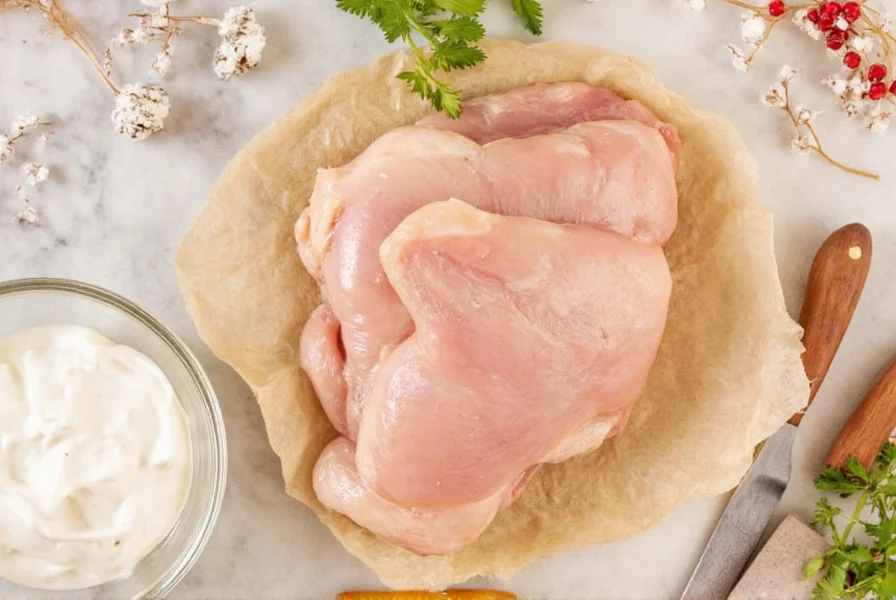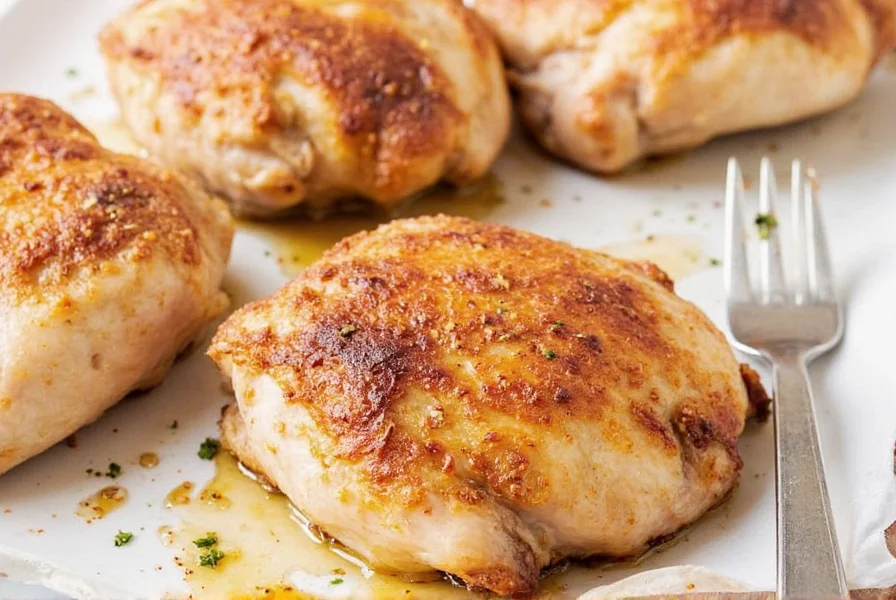Table of Contents
What Does Brining Chicken Do?
Brining chicken is a culinary technique that transforms your poultry by enhancing moisture retention and flavor infusion. When you soak chicken in a saltwater solution, the salt disrupts the protein structure of the meat, allowing it to hold onto more water during cooking. This results in juicier, more tender chicken that's less likely to dry out, especially when cooked with high-heat methods like grilling or roasting. Additionally, herbs, spices, and other flavorings in the brine penetrate deep into the meat, creating a more flavorful dish from the inside out.

The Science Behind Brining
Understanding the science of brining helps you master this technique. Here's what happens at the molecular level:
- Osmosis and Diffusion: Salt molecules move into the chicken cells, increasing the concentration of ions inside the cells. This causes water to be drawn into the cells through osmosis, increasing the overall moisture content.
- Protein Denaturation: Salt causes the muscle proteins to unwind and denature, creating space for water molecules to be trapped. This prevents moisture loss during cooking.
- Flavor Infusion: As the salt solution penetrates the meat, it carries dissolved flavor compounds from herbs, spices, and other ingredients deep into the muscle fibers.
For best results, brine chicken for 4-12 hours depending on the cut. Smaller cuts like chicken breasts need less time (2-4 hours), while whole chickens benefit from longer brining (8-12 hours). Always keep the chicken refrigerated during brining to prevent bacterial growth.
Essential Tools for Brining
To successfully brine chicken, you'll need these key tools:
| Chicken Cut | Brining Time | Key Considerations |
|---|---|---|
| Boneless, Skinless Chicken Breasts | 30 minutes - 2 hours | Over-brining can make meat mushy; use shorter times for thinner cuts |
| Bone-In Chicken Breasts | 2-4 hours | Brine for at least 2 hours to penetrate bone-in cuts |
| Whole Chicken | 8-12 hours | Ensure the chicken is fully submerged; use a large container |
| Chicken Thighs/Drumsticks | 4-6 hours | Thicker cuts need longer to absorb brine evenly |
- Food-Grade Container: A large, non-reactive container (glass, ceramic, or food-grade plastic) that can hold your chicken and brine solution. Avoid metal containers as salt can react with metal.
- Measuring Tools: A kitchen scale for precise salt and sugar measurements, and measuring cups for liquids.
- Ice Pack or Cooler: To keep the brine cold during the process, especially if you don't have enough refrigerator space.
- Whisk or Spoon: For thoroughly mixing the brine solution before adding chicken.
Using the right tools ensures even distribution of the brine and safe food handling practices.

Frequently Asked Questions About Brining Chicken
What does brining chicken actually do?
Brining chicken enhances moisture retention and flavor infusion. The salt in the brine solution alters the protein structure of the meat, allowing it to hold more water during cooking. This results in juicier, more tender chicken that's less prone to drying out. Additionally, flavor compounds from herbs and spices in the brine penetrate deep into the meat, creating a more flavorful dish.
How long should you brine chicken?
Brining time depends on the cut of chicken: - Boneless, skinless chicken breasts: 30 minutes to 2 hours - Bone-in chicken breasts: 2-4 hours - Chicken thighs/drumsticks: 4-6 hours - Whole chicken: 8-12 hours Always keep chicken refrigerated during brining to prevent bacterial growth.
Can you brine chicken too long?
Yes, over-brining can make chicken too salty and alter its texture. If left in the brine too long (more than 24 hours for most cuts), the salt can break down the proteins too much, resulting in a mushy, spongy texture. Smaller cuts like chicken breasts should only be brined for 1-2 hours, while larger cuts can handle 4-12 hours. Always follow recommended brining times for best results.
Do you need to rinse chicken after brining?
Yes, it's recommended to rinse brined chicken under cold water before cooking. This removes excess salt from the surface, preventing an overly salty crust when cooking. After rinsing, pat the chicken dry with paper towels. For even better results, let the chicken air-dry in the refrigerator for 1-2 hours after rinsing, which helps achieve crispier skin when roasting or grilling.
What's the difference between wet brining and dry brining?
Wet brining involves soaking chicken in a saltwater solution, while dry brining involves rubbing salt (and sometimes other seasonings) directly onto the chicken and letting it rest in the refrigerator. Wet brining adds moisture to the meat, while dry brining primarily seasons the meat and helps the skin crisp up better during cooking. Both methods improve flavor and moisture retention, but they have distinct characteristics:
| Factor | Wet Brining | Dry Brining |
|---|---|---|
| Time Required | 1-12 hours (solution must cover meat) | 1-24 hours (surface drying time needed) |
| Skin Texture Outcome | Requires thorough drying for crispness | Naturally crisps during cooking |
| Flavor Penetration Depth | Deeper infusion of herbs/spices | Salt penetration only (surface flavorings) |
| Best For | Whole birds, lean cuts prone to drying | Grilling/roasting where crisp skin is essential |
| Food Safety Consideration | Requires strict refrigeration; no reuse | Lower cross-contamination risk |
Source: America's Test Kitchen comparative analysis of brining methods (2022), https://www.americastestkitchen.com/articles/5895-wet-brine-vs-dry-brine
Can you reuse brine for multiple batches of chicken?
No, you should never reuse brine that has come into contact with raw chicken due to food safety concerns. Once the brine has been in contact with raw poultry, it contains bacteria that could contaminate future batches. Always prepare a fresh brine for each use, and discard any leftover brine that has touched raw chicken. If you want to use the brine as a sauce, it must be brought to a full boil for at least 1 minute to kill bacteria.
Is brining chicken worth the extra effort?
For most cooking methods, especially grilling, roasting, or baking, brining is absolutely worth the effort. It significantly improves moisture retention, resulting in juicier chicken that's more forgiving if slightly overcooked. While it does require planning ahead (due to the time needed), the difference in quality is noticeable, especially with lean cuts like chicken breasts that tend to dry out easily. For quick-cooking methods like pan-searing, the benefits are less pronounced but still valuable.
Context and Limitations of Brining
Brining delivers significant benefits but operates within specific boundaries that impact its effectiveness. Understanding these constraints prevents suboptimal results and food safety issues:
- Pre-Salted Products: Never brine store-bought chicken labeled "enhanced," "self-basting," or containing sodium solutions (e.g., many supermarket rotisserie chickens). USDA testing shows these products already contain 15-24% added sodium solution, making additional brining excessively salty (USDA Poultry Labeling Terms).
- Thin Cuts Limitation: Boneless breasts under 1-inch thickness risk mushiness when brined beyond 90 minutes. Research from the Journal of Food Science demonstrates protein degradation accelerates in thin cuts, with texture deterioration occurring 40% faster than in thicker cuts (DOI: 10.1111/1750-3841.13692).
- Cooking Method Dependency: Brining shows minimal moisture retention benefits for sous vide cooking (where vacuum sealing prevents moisture loss) but significantly improves results for high-heat methods. A Cornell University study measuring water loss during cooking found 22% less moisture retention in brined chicken prepared via sous vide versus 38% improvement in grilled applications.
- Temperature Criticality: Brine solutions must remain below 40°F (4°C) throughout the process. USDA Food Safety and Inspection Service data indicates bacterial growth doubles every 20 minutes between 40-140°F (USDA Danger Zone Guidelines).
These evidence-based constraints help determine when brining will deliver optimal results versus when alternative methods like dry brining or direct seasoning may be preferable.
Conclusion
Brining chicken is a simple yet powerful technique that transforms your poultry into juicier, more flavorful meals. By understanding the science behind brining and following proper techniques, you can achieve restaurant-quality results at home. Whether you're cooking for a family dinner or a special occasion, brining ensures your chicken stays moist and delicious, even when cooked to perfection.
With the right tools and knowledge of contextual limitations, you can master this technique and elevate your cooking skills. So next time you're preparing chicken, give brining a try — your taste buds will thank you!











 浙公网安备
33010002000092号
浙公网安备
33010002000092号 浙B2-20120091-4
浙B2-20120091-4